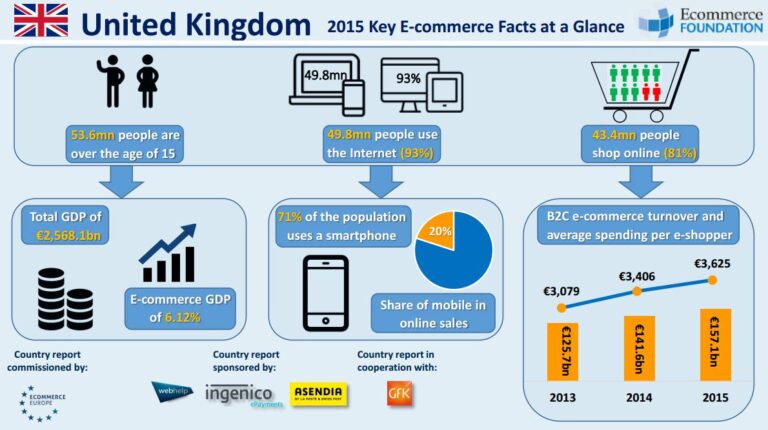The United Kingdom’s e-commerce sector continues to experience rapid growth, solidifying its position as one of the most dynamic digital markets in Europe. According to recent data from Statista, online retail sales in the UK have surged markedly, driven by shifting consumer behaviors, technological advancements, and the lasting impact of the COVID-19 pandemic. This article delves into the latest statistics, trends, and insights shaping the UK’s e-commerce landscape, highlighting key factors influencing both businesses and shoppers in a competitive and evolving marketplace.
E-commerce Growth Trends Shaping the UK Retail Landscape
Recent years have witnessed a seismic shift in how UK consumers shop, with digital platforms fueling unprecedented e-commerce expansion. A surge in mobile shopping, accelerated by improved smartphone penetration and faster internet speeds, continues to reshape purchasing behaviors. Retailers are increasingly prioritizing omnichannel strategies, blending online convenience with physical store experiences. Alongside this, the rise of social commerce and influencer partnerships is creating new touchpoints that drive engagement and sales, particularly among younger demographics.
Data from Statista highlights notable trends contributing to the market’s dynamism:
- Growth in cross-border online shopping: UK consumers are increasingly buying from international retailers, spurred by competitive pricing and wider product availability.
- Sustainability focus: Eco-conscious choices are influencing e-commerce operations, from packaging innovations to greener delivery options.
- Technological innovation: AI-driven personalization and augmented reality features are enhancing customer experience, reducing return rates and boosting satisfaction.
| Trend | Impact 2023 | Forecast 2025 |
|---|---|---|
| Mobile Commerce | 42% of total e-commerce sales | 60% expected increase |
| Social Commerce | £4.5 billion revenue | Projected £8 billion |
| Green Delivery Options | 12% of shipments | 30% adoption |
Consumer Behavior Insights Drive Online Shopping Patterns
Understanding the intricate motivations behind UK shoppers’ online decisions reveals a dynamic landscape shaped by convenience, trust, and personalization. Recent studies highlight that ease of navigation, fast delivery options, and mobile-friendly interfaces significantly boost consumer engagement and conversion rates. Additionally, social proof through customer reviews and seamless payment systems have emerged as critical factors convincing hesitant buyers to complete their purchases. Retailers leveraging data analytics to anticipate shopping habits are also capitalizing on tailored promotions, increasing the average order value and fostering brand loyalty in a highly competitive market.
Emerging trends reflect a shift towards sustainable and ethical consumption, with a growing percentage of consumers prioritizing eco-friendly products and transparent sourcing. The following snapshot demonstrates key factors influencing UK online buyers in 2024:
| Key Drivers | Percentage of Shoppers Influenced |
|---|---|
| Convenience (fast checkout, delivery options) | 78% |
| Customer Reviews & Ratings | 65% |
| Personalized Recommendations | 54% |
| Sustainable Product Availability | 48% |
| Price Competitiveness | 72% |
Strategies for Businesses to Capitalize on UK E-commerce Expansion
Businesses aiming to thrive amid the dynamic UK e-commerce surge must focus on enhancing personalization and customer experience. Leveraging AI-powered analytics enables companies to tailor product recommendations based on consumer behavior, driving higher conversion rates and fostering brand loyalty. Additionally, optimizing mobile platforms is crucial as mobile commerce accounts for a significant share of online transactions. Streamlined, intuitive apps and responsive websites boost engagement while reducing cart abandonment.
To stay competitive, brands should also invest in robust omnichannel strategies that blend physical and digital presences seamlessly. Utilizing localized fulfillment centers accelerates delivery times, a critical factor for consumer satisfaction in the UK market. The following table highlights key tactics businesses are adopting to capitalize on this expansion:
| Strategy | Impact | Implementation Focus |
|---|---|---|
| AI-Driven Personalization | +20% sales uplift | Customer data platforms |
| Mobile Optimization | 35% higher engagement | Responsive design, PWA |
| Omnichannel Fulfillment | Reduced delivery time by 30% | Local warehousing, click & collect |
- Integrate AI tools to analyze real-time consumer data.
- Design mobile-first e-commerce platforms and implement Progressive Web Apps (PWAs).
- Develop seamless omnichannel experiences combining in-store and online touchpoints.
- Establish localized fulfillment centers to expedite shipping and support click & collect options.
- Continuously monitor customer feedback to refine personalization and service quality.
In Conclusion
In conclusion, the landscape of e-commerce in the United Kingdom continues to evolve rapidly, driven by shifting consumer behaviors and technological advancements. As highlighted by the latest Statista data, the sector remains a vital component of the UK economy, offering both opportunities and challenges for retailers and policymakers alike. Staying attuned to these trends will be essential for businesses aiming to thrive in this dynamic market.




